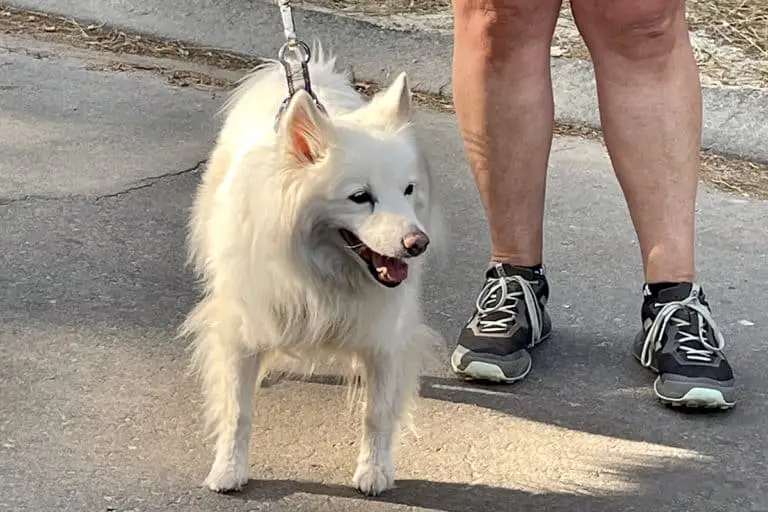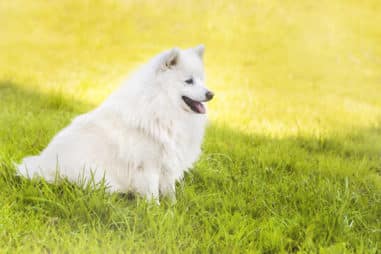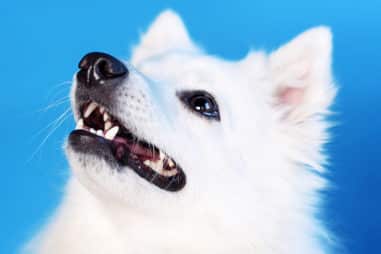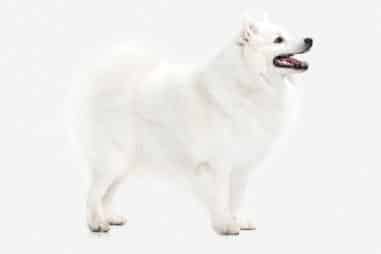Training a Japanese Spitz nowadays is no longer seen as a very challenging undertaking. The chances of receiving the best results are rather good, whether you enlist the services of a professional dog trainer or if you opt instead to do it on your own. This is mostly due to the fact that training a Japanese Spitz dog is not a particularly complicated process.
Are Japanese Spitz Easy to Train?
Japanese Spitz puppies are docile, hence they are very easy to train. This breed of dog learns most when it receives constant training. So, if you really want them to learn something, say, basic obedience training, we strongly advise you to start them at a young age.
The Spitz breed comes in three different types. They are the Finnish, the Japanese, and the German varieties. The Japanese Spitz breed is the most sought out by dog lovers. One of the reasons is because of their high level of doggy intelligence and trainability. Since human behaviour is a driver for Spitz dogs, the actions of their owners or human companions are likely to have an impact on the training process.
With regards to training, the Finnish Spitz has a natural tendency to be stubborn at times. But the Spitz breeds are fast learners because they are intelligent and clever.
As for the German Spitz, these dogs usually have a temperamental nature which often shadows their affectionate personality. With this natural characteristic of the German Spitz dog, it can make training them a bit more challenging than the Finnish Spitz and the Japanese Spitz.
How Smart Are Japanese Spitzes?
The Japanese Spitz dog is among the most intelligent breeds in the dog kingdom. They are remarkably intelligent and bright, eager to please their humans all the time. You can even teach them a wide variety of commands and disciplines.
Ideally, you can give this breed basic obedience training, either in a formal setup or just on your own. Other suggested training methods ideal for this breed include crate training and leash training. You can start with the “come” command first. This will initially introduce him to the concept of “following orders” from you.
If you keep training sessions with a Japanese Spitz dog brief and targeted, you will see your desired results in no time. Training this breed is a cinch because these dogs are innately clever, obedient, and ready to please, you just need consistency. The Japanese Spitz, in comparison to other Spitz breeds, responds exceptionally well when given positive reinforcement training.
They are not difficult to train, but make sure you as their human, follow through on your orders or commands. They are quick to pick up new skills and shine at agility games such as Frisbees or fetch a ball.
According to some experts in Japanese Spitz dogs, this breed bags a score of 3 out of 5 on a scale of highly intelligent and smart breeds of dogs.
Various pet behaviour specialists also say that the brainpower of a Japanese Spitz is comparable to that of a human child between the ages of 2 and 2.5 years.
What we have below are amazing facts about the intellect of Japanese Spitzes and the relative intelligence of other canines in comparison to humans:
- The average Japanese Spitz is capable of learning approximately 165 words. This would include signals and hand gestures. While others, dubbed as “super pets” or more intelligent breeds of dogs, may learn approximately 250 words.
- Japanese Spitzes are capable of counting up to four or five.
- Whilst playing, Japanese Spitzes can deliberately deceive other dogs and people so they can merit/obtain rewards like treats.
Are Japanese Spitz Easy to Potty Train?
Japanese Spitz or not, the metabolism of puppies is different from those of adult canines. Their organs and muscles are not completely developed yet. This explains the reason why they cannot control themselves when they need to take a whiz. Thus, they tend to wee in random places. After three months, a Japanese Spitz puppy will be able to control its bladder only for a short period of time.
Furthermore, the duration of the retention is expected to be no more than two hours in length. This is why most people who are attempting to potty train their Japanese Spitz start doing so when their puppies reach the age of three months old.
Once your Japanese Spitz puppy is old enough (3months old), you should take him outside to “do his business” every hour. The best time to do this is after your Japanese Spitz has woken up from a nap, before taking his meal or engaging in a play.
When you see signs that your Japanese Spitz puppy wants to potty, it is time to take him outside. At first, the signs will be quite subtle. Therefore, you really have to keep an eye on him. Otherwise, you may not notice anything at all.
If your puppy’s bladder is full when he sleeps, he’ll try to flee his sleeping area in search of a peaceful destination to pee – preferably in the yard or beneath his favorite tree.
Japanese Spitz puppies tend to become embarrassed when being watched by their humans while taking a pee. But they are so good at pretending nothing is wrong if you notice them doing their business.
It’s up to you how you keep a watchful eye on your puppy for these telltale signs that will indicate when they are about to answer the call of nature.
How to Mentally Stimulate/Challenge a Japanese Spitz?
Let your Japanese Spitz dog smell a toy. Then hide it under one of three or four cups and let your dog find where the toy is hidden. Your pooch will have to use its brain and nose to accomplish this, which makes your dog feel good mentally. You can play this game with your furbaby for about 15 minutes.
Another activity that can help challenge your dog’s mental faculties to a great extent is a training session that is focused on trick training. Typical examples of which include barking on command or standing on hind legs.
Doing something new and different once in a while is also a wonderful way to give your dog mental stimulation. This is an important part of this dog’s life. They can only be provided by humans, particularly by their owners.
In most cases, the Japanese Spitz dogs do not get enough mental stimulation or activity, and all because their owners are unaware of what exactly they need to do. Hence, on very rare occasions disruptive behavior are usually seen to stem from a lack of mental activity for them.
Do Japanese Spitz Need a Lot of Exercises?
The Japanese Spitz is a high-energy dog that is quite bright and requires 60 to 90 minutes of activity and exercises each day. But these dogs would be delighted to play with you, their human, for much longer.
In the absence of an opportunity to expend their pent up energy and bend their mental faculties, these dogs could be up for behavior issues. Barking, digging, destructive conduct, and escaping to explore on their own are all indications of such problems.
Every day, as much as possible, a Japanese Spitz will need three kinds of exercise and activity.
- Daily walk
- Purposeful activity (such as fetching a ball, running in the garden, etc)
- Mental stimulation
These dogs have a lot of stored energy within themselves. Your Japanese Spitz puppy will need to be challenged and stimulated in those 3 aspects above if it is to become a well-behaved, well-mannered pooch. By providing dogs with daily mental stimulation, we can accomplish that.
How Much Exercise Does a Japanese Spitz Need?
A puppy’s and an adult Japanese Spitz’s exercise requirements differ from each other. The bones, muscles, and joints of puppies are still developing and growing. Therefore, their bodies tend to require more movement.
The amount of exercise required by older dogs is lesser compared to puppies, or younger canines. But that does not negate the fact that regular activity is still important to keep them in tip-top shape. Exercise and moving about will help them to keep their muscles and joints supple and their weight at a more manageable level.
The best way to decide how much exercise is right for your dog is to ask your veterinarian for advice on this and on what type of play will be beneficial for them. A good starting point is to calculate a minimum of 30 minutes of exercise per day.
A walk around the block accompanied by plenty of playtime inside and outside the confines of your yard will be fine during the warmer weather months. If you happen to be living in regions where there is a colder climate, some type of indoor activity is most recommended. This may require the use of proper dog toys, such as those made from sound rubber.
Puppies will need even more exercise than adults because they are growing muscles, bones and joints at an amazing rate.
Even young puppies should be allowed out of the crate for playtime once they have been house trained. This is vital to help optimize their physical and mental development. How often you take them out of the crate will depend upon how long it takes them to become fully house trained.
During the colder months, be careful not to push young puppies to their limits. Their little lungs are still developing and they will be more prone to developing respiratory problems in their adult life if they are pushed beyond their capabilities while they are still very young.
Sometimes it can be difficult to get the proper amount of exercise due to weather, location or other issues. Try to walk your dog around the block at least once a day and take him/her out for playtime every day, even if it is only for five minutes.
How Long Should You Walk a Japanese Spitz?
Not only for exercising but also for releasing pent-up energy, a Japanese Spitz needs to have his daily walks. While walking, your pooch will be exposed to a myriad of sights, sounds, and smells. This works to the benefit of the dog because it will help in stimulating their minds.
Ideally, a walk in the park alongside a Japanese Spitz should last between 30 and 45 minutes each day. If your schedule allows, walk two times a day if you are able to do so.
It is also good for this breed of dog to have a consistent routine. Therefore, we encourage you to try to take your pooch on walks at the same time every day. There are many benefits to walking daily rather than walking only on weekends.
A walk in the park without a leash is most ideal if you have a Japanese Spitz with good recall and comes back to you when his name is being called out. In addition to burning off more energy, brisk walking is also a great mental stimulant for dogs.
However, due to their strong prey and chase instincts, Japanese Spitzes are not that good off-leash. If you want to give your dogs more freedom while keeping them under control, you can use a retractable leash instead.
How Long Can a Japanese Spitz Walk?
Dogs will generally enjoy a walk of one to three miles, but if your pooch enjoys covering ground, she may end up walking 10 miles or more. Until she has reached maturity and is fully grown, a puppy shouldn’t cover more than a few miles.
You and your dog’s covered distance during brisk walking will vary significantly depending on your pace. If you stroll with an older dog or a small dog, you won’t cover much ground, but if you walk briskly with a larger dog, you would naturally cover a lot of ground.
Sticking to your side or staying consistently behind or ahead of you will make it possible for your dog to cover a greater distance while on a walk. The key to encouraging your dog to walk more distance and thus cover more ground is to throw her favourite toy short distances to fetch or use a flirt pole.
Bear in mind that if you have a tiny breed of dog, she will already expend more energy than you do by trotting rather than strolling.
Can You Run With a Japanese Spitz?
If you are living in an urban setting, it is ideal to have a Japanese Spitz by your side. It is because they are easy travellers, thanks to their small stature. This breed of dog holds a good potential when it comes to training for agility sports.
If your favorite form of exercise is running or jogging, these dogs make excellent running partners if you aren’t too fast on your feet.
But, if you’re as fast as Jamaican sprinter Usain Bolt or if you’re riding a bicycle, it’s understandable that your dog will have a difficult time keeping up with your pace.
How Long Can a Japanese Spitz Run?
While this canine breed naturally has little legs, maintaining an active lifestyle is of paramount importance to the overall well being of a Japanese spitz. This will take around 45 minutes of running, walking, or fetching each day.
This is one of the most effective measures to take if you want to keep their tails wagging. While these pups tend to be anxious and agitated when left alone, they’re most happy and bouncy when they are with their humans.
According to leading dog care specialists, 30 minutes to 2 hours of physical activity is good for most dogs every day. Walking your dog is as far as you can go, and as long as they’re content. For some dogs, it’s a whole neighbourhood away. Some think it’s only 10 miles.
How Fast Can a Japanese Spitz Run?
The average dog’s running speed is determined by its body composition and breed. All dogs, however, share certain common denominators and characteristics that make them potentially good runners.
One is their feet. They are capable of gripping and sensing the ground, in addition to nails for traction. They provide dogs with exceptional turning abilities and complex gaits.
When running at the height of their speed, this double-suspension gallop maximizes speed and distance. Their extended loins, strong abdominal muscles, and flexible spine give them plenty of forward drive and staying power.
Over short distances, the Japanese Spitz can reach speeds of up to 15–20 miles per hour.However, other breeds can go far slower than that, while others run much quicker. The speed of a running dog is determined by its physical makeup, breed, and overall health.
How High Can a Japanese Spitz Jump?
Despite the fact that Japanese Spitz dogs can frequently run great distances (subject to their overall health, of course), they are unlikely to run you off your feet. With their high level of athleticism and innate agility, as well as their superb jumping abilities, the Japanese Spitz dog is often seen as the one that is most capable of bringing home the bacon in the majority of canine sports such as nose work, agility, flyball, obedience, and rally.
These dogs can jump extremely high. With respect to their sheer size, there is no way anyone would anticipate they would be capable of such a feat. For this reason, Japanese Spitz dog owners are encouraged to have their fences and gates raised to at least 1.5m to 1.8m high. Doing so will help discourage their pooch from trying to leap or jump off fences.
Do Japanese Spitz Like to Swim?
A Japanese Spitz dog is one of those canine breeds that, without a doubt, love the great outdoors. They are a very energetic breed who love to play outside. Their exercise should last around 45 minutes, ideally divided into smaller walks.
Japanese Spitz dogs enjoy variety in their physical activity and are also likely to enjoy swimming occasionally. Because of their fun-loving nature, it is not all that surprising to see them often be the first ones to hop into a pool of water.
Japanese Spitz dogs also like the idea of running alongside their humans on occasion. Moreover, this breed may take part in various canine sports such as flyball, advanced obedience, agility or frisbee.
Do Japanese Spitz Like to Dig?
Digging is an instinctive behavior shared by everyone in the canine kingdom, and the Spitz breed is no exception to this, including the Japanese variety. Most Japanese Spitz dogs are keen diggers, which can sometimes be troublesome to their owners.
Unfortunately, there is no proven way or measure that will help owners to completely train their pooch and this instinctive behavior they have out of their system. However, there is a silver lining of hope here because there are several ways to distract them and redirect them.
The Japanese Spitz, or dogs in general, resort to digging for various reasons. One common ground is boredom, so these dogs channel their energies into digging random areas in, say, backyard space to escape and find some adventure or to occupy themselves. If a lack of exercise is contributing to your Japanese Spitz digging, aim to increase it.
If your Japanese Spitz is digging near the fence or gate, they are probably trying to find a way out to escape their jadedness.
What Can You Do to Stop Japanese Spitz Dogs from Digging?
You could try to stuff something inside the hole. This could help deter them from further digging into that spot.
If your Japanese Spitz dog is into this destructive habit and has already dug holes in your backyard or garden, you can fill the holes they made with a variety of materials. Several examples include the following:
- Dogs, particularly the Japanese Spitz breed, will stop digging in areas where they have pooped or where traces of their fecal matter can be found.
- Citrus peels, chilli peppers, or vinegar. Dogs will find these items too irritating for their olfactory organs, hence a very effective deterrent for digging.
- Bury rocks. For this, we suggest that you consider the use of large flat ones. The cumbersomeness of natural flat rocks will discourage a persistent Japanese Spitz from digging.
Put plastic netting barely underneath the surface of identified digging sites for your pooch and bury it there for, say, several days. However, veer away from the use of metal wire because doing so will just expose their paws to accidental cutting.








